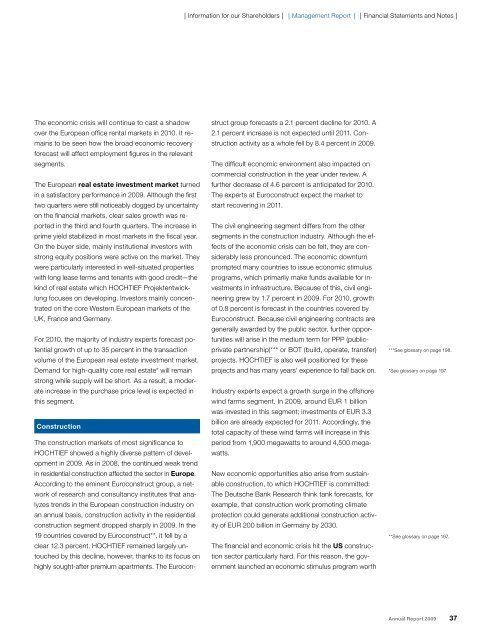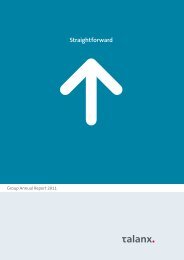ONE ROOF
ONE ROOF
ONE ROOF
You also want an ePaper? Increase the reach of your titles
YUMPU automatically turns print PDFs into web optimized ePapers that Google loves.
The economic crisis will continue to cast a shadow<br />
over the European office rental markets in 2010. It remains<br />
to be seen how the broad economic recovery<br />
forecast will affect employment figures in the relevant<br />
segments.<br />
The European real estate investment market turned<br />
in a satisfactory performance in 2009. Although the first<br />
two quarters were still noticeably dogged by uncertainty<br />
on the financial markets, clear sales growth was reported<br />
in the third and fourth quarters. The increase in<br />
prime yield stabilized in most markets in the fiscal year.<br />
On the buyer side, mainly institutional investors with<br />
strong equity positions were active on the market. They<br />
were particularly interested in wellsituated properties<br />
with long lease terms and tenants with good credit—the<br />
kind of real estate which HOCHTIEF Projektentwicklung<br />
focuses on developing. Investors mainly concentrated<br />
on the core Western European markets of the<br />
UK, France and Germany.<br />
For 2010, the majority of industry experts forecast po<br />
tential growth of up to 35 percent in the transaction<br />
volume of the European real estate investment market.<br />
Demand for highquality core real estate* will remain<br />
strong while supply will be short. As a result, a moderate<br />
increase in the purchase price level is expected in<br />
this segment.<br />
Construction<br />
The construction markets of most significance to<br />
HOCHTIEF showed a highly diverse pattern of development<br />
in 2009. As in 2008, the continued weak trend<br />
in residential construction affected the sector in Europe.<br />
According to the eminent Euroconstruct group, a network<br />
of research and consultancy institutes that analyzes<br />
trends in the European construction industry on<br />
an annual basis, construction activity in the residential<br />
construction segment dropped sharply in 2009. In the<br />
19 countries covered by Euroconstruct**, it fell by a<br />
clear 12.3 percent. HOCHTIEF remained largely untouched<br />
by this decline, however, thanks to its focus on<br />
highly soughtafter premium apartments. The Eurocon<br />
❘ Information for our Shareholders ❘ ❘ Management Report ❘ ❘ Financial Statements and Notes ❘<br />
struct group forecasts a 2.1 percent decline for 2010. A<br />
2.1 percent increase is not expected until 2011. Construction<br />
activity as a whole fell by 8.4 percent in 2009.<br />
The difficult economic environment also impacted on<br />
commercial construction in the year under review. A<br />
further decrease of 4.6 percent is anticipated for 2010.<br />
The experts at Euroconstruct expect the market to<br />
start recovering in 2011.<br />
The civil engineering segment differs from the other<br />
segments in the construction industry. Although the effects<br />
of the economic crisis can be felt, they are considerably<br />
less pronounced. The economic downturn<br />
prompted many countries to issue economic stimulus<br />
programs, which primarily make funds available for investments<br />
in infrastructure. Because of this, civil engineering<br />
grew by 1.7 percent in 2009. For 2010, growth<br />
of 0.8 percent is forecast in the countries covered by<br />
Euroconstruct. Because civil engineering contracts are<br />
generally awarded by the public sector, further opportunities<br />
will arise in the medium term for PPP (publicprivate<br />
partnership)*** or BOT (build, operate, transfer)<br />
projects. HOCHTIEF is also well positioned for these<br />
projects and has many years’ experience to fall back on.<br />
Industry experts expect a growth surge in the offshore<br />
wind farms segment. In 2009, around EUR 1 billion<br />
was invested in this segment; investments of EUR 3.3<br />
billion are already expected for 2011. Accordingly, the<br />
total capacity of these wind farms will increase in this<br />
period from 1,900 megawatts to around 4,500 megawatts.<br />
New economic opportunities also arise from sustain<br />
able construction, to which HOCHTIEF is committed:<br />
The Deutsche Bank Research think tank forecasts, for<br />
example, that construction work promoting climate<br />
protection could generate additional construction activity<br />
of EUR 200 billion in Germany by 2030.<br />
The financial and economic crisis hit the US construc<br />
tion sector particularly hard. For this reason, the gov<br />
ernment launched an economic stimulus program worth<br />
***See glossary on page 198.<br />
*See glossary on page 197.<br />
**See glossary on page 197.<br />
Annual Report 2009 37
















